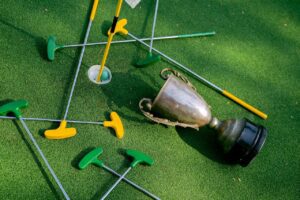Got the golf fever? Eventually, every passionate golfer feels the itch to upgrade their trusty clubs. But what to do with the old faithful? Whether it’s to keep up with the latest technology or because our clubs have seen better days, simply tossing them out isn’t the smartest move. Not only can it harm the environment, but it’s also a missed opportunity for some fun and originality. Fear not, for there are plenty of exciting ways to breathe new life into our used golf clubs while keeping waste to a minimum. Let’s explore these 7 things that you can do with your old golf balls.
The Environmental Impact of Discarding Golf Clubs
When you dispose of obsolete golf equipment without considering the environmental impact, you contribute to additional e-waste. Metal, graphite, and plastic are among the materials used to make golf clubs. This may not appear to be a major issue. These materials may take decades or even centuries to disintegrate in a landfill. Not to mention that producing new golf clubs needs the exploitation of natural resources as well as the expenditure of major energy, both of which contribute to environmental damage.
But fear not! There is a way to make a positive change. Instead of getting rid of your old clubs, why not find alternative uses for them? By doing so, you’ll reduce the need for new clubs and help minimize your carbon footprint. It’s a win-win situation!
Creative Ways to Repurpose Old Golf Clubs
- Donate to Junior Golf Programs: Consider donating your old golf clubs to junior golf programs in your community. These programs often rely on donations to provide equipment to aspiring young golfers who may not have the means to purchase their own clubs.
- Create Decorative Pieces: Old golf clubs can be transformed into unique and eye-catching decorative pieces for your home or garden. Use them to create a coat hanger, a lamp base, or even a plant stand. Let your creativity guide you!
- Repurpose for Yard Games: Turn your old golf clubs into outdoor games for the whole family to enjoy. Use the clubs as makeshift goalposts for backyard soccer, or attach a small net to create a DIY golf putting challenge.
- Sell or Trade-In: If your old golf clubs are still in good condition, consider selling them or trading them in at a golf shop. This way, someone else can benefit from their use, and you can put the proceeds towards your new set of clubs.
Remember that reusing obsolete golf clubs not only lowers trash but also encourages a more environmentally friendly approach to the sport we all enjoy. So, when it comes to reusing your old clubs, get creative and think outside the box!
We can reduce our environmental effect and contribute to a more sustainable future by exploring creative methods to recycle obsolete golf equipment.
Hopefully, these ideas have piqued your interest and inspired you to give your old clubs a second opportunity. We can make a difference one club at a time if we work together!
RELATED: What is The Range of an Electric Golf Cart?
1. Donate to Charity or Youth Programs

If you have old golf clubs lying around and you’re not sure what to do with them, consider donating them to charity or youth programs. There are several benefits to donating your old golf clubs and numerous organizations that accept donations.
Benefits of Donating Golf Clubs
Donating your old golf clubs can positively impact others and the community. Here are some key benefits:
- Promoting inclusivity: Donating golf clubs to charity or youth programs can provide individuals who may not have the financial means with an opportunity to enjoy the sport. This promotes inclusivity and allows more people to experience the joys of playing golf.
- Supporting youth development: Golf is used by many youth programmes and organisations to teach life values such as discipline, patience, and persistence. You are supporting these programmes and assisting young people in developing vital character characteristics by giving your old clubs.
- Reducing waste:Rather than allowing your old golf clubs to collect dust or wind up in a landfill, donating them enables for reuse and saves waste. You are also helping to environmental initiatives by giving your clubs a second life.
Organizations that Accept Donations of Golf Clubs
There are several organizations that accept donations of golf clubs. Here are a few reputable ones:
- The First Tee: The First Tee is a youth development organization that promotes character education through golf. They accept donations of golf clubs and other equipment to support their programs.
- PGA REACH: PGA REACH is the charitable foundation of the PGA of America. They work to create accessible and inclusive golf opportunities for all. They accept donations of golf clubs and equipment to support their initiatives.
- Local charities and youth programs: Many local charities and youth programs, such as Boys & Girls Clubs and community sports programs, accept donations of golf clubs. Reach out to organizations in your area to inquire about their donation policies.
Before giving your golf clubs, be sure they are in good shape and usable. While mild wear and tear is allowed, clubs that are irreparably broken may be unsuitable for donation. Cleaning the clubs and removing any personal identification markings you may have created is also a good idea.
Donating your old golf clubs is a fantastic way to give back to the community and support youth programs. By providing others with the opportunity to enjoy the sport, you can contribute to the growth of golf and make a positive impact on individuals’ lives. So, gather up those old golf clubs and donate them to a worthy cause!
2. Sell or Trade-In
If you have old golf clubs that you don’t know what to do with, one option is to sell or trade them in. This might be a terrific way to tidy your area while also making some money. Here are some pointers on how to sell or trade in your old golf clubs.
Tips for Selling or Trading In Old Golf Clubs
- Clean and condition the clubs: Before selling or trading in your old golf clubs, it’s essential to clean them up and make them presentable. Remove any dirt or debris from the clubheads and grips, and give them a polish if necessary.
- Research their value: Take some time to research the value of your old golf clubs. Factors such as the brand, model, condition, and age will determine their worth. You can use online resources or consult with golf equipment experts to get an idea of how much you can sell or trade them for.
- Take quality photos: When listing your old golf clubs for sale or trade, it’s crucial to take quality photos that accurately depict their condition. Clear and well-lit images will attract potential buyers and give them a better idea of what they’re getting.
- Be honest about the condition: When describing your old golf clubs, be honest about their condition. Mention any wear and tear or flaws they may have. This will build trust with potential buyers and help manage their expectations.
Websites and Platforms for Selling Golf Clubs
If you decide to sell your old golf clubs, several websites and platforms cater to golf enthusiasts looking for used equipment. Here are a few options to consider:
- eBay: eBay is a popular online marketplace where you can list your old golf clubs for sale. You can set a starting bid or choose to sell them at a fixed price.
- Golf-specific marketplaces: Websites such as GolfWRX, GlobalGolf, and 2nd Swing specialize in selling new and used golf equipment. These platforms attract a specific audience of golf enthusiasts, making it easier to find interested buyers.
Find a golf club marketplace
A local golf club marketplace or pro shop is another option for selling or trading in your old golf equipment. Many golf courses feature a section where golfers may purchase, sell, or swap used equipment. You may enquire at your local golf courses or seek for neighbouring possibilities online.
Donate or give them away
If selling or trading in your old golf clubs isn’t your thing, try donating them to charity or gifting them to family, friends, or new golfers. Many organisations and programmes accept golf club contributions in order to offer equipment to aspiring golfers who may not be able to afford their own.
Finally, when considering what to do with your old golf clubs, selling or trading them in might be a profitable alternative. When selling the clubs for sale, make sure to clean and condition them, investigate their worth, and utilise high-quality images. You may also donate them to charitable organisations or gift them to others who would benefit from utilising them on their golfing adventure.
RELATED: 8 Most Expensive Golf Balls in the World
3. Gift or Pass Them On

As a golf enthusiast, you may accumulate a collection of old golf clubs over time. While these clubs may no longer be your go-to equipment, they can still serve a purpose and bring joy to others. Here are a couple of ideas on what to do with your old golf clubs:
Sharing the Love of Golf: Giving Golf Clubs as Gifts
One great way to repurpose your old golf clubs is by giving them as gifts. If you have a family member, friend, or colleague who is just starting to get into golf, your old clubs can be a perfect introduction to the sport. Not only will it save them money on purchasing new equipment, but it will also show your support and enthusiasm for their new hobby. You can also consider giving these clubs as prizes for charity events or golf tournaments, spreading the love of golf to a wider audience.
Passing on Old Golf Clubs to Family or Friends
Passing on your old golf clubs to relatives or friends is another option. Perhaps you have a sibling or a youngster that is interested in golf. You may promote their desire and equip them with the tools they need to enhance their game by gifting them your old clubs. It may be a memorable way to spend time together on the golf field and bond. Furthermore, if you have friends who are casual golfers or want to try the sport, giving them your old clubs might be a great way to get them interested and have a fun day together.
If none of these choices work for you, consider selling or donating your old golf clubs. There may be aficionados or beginners willing to acquire them at a fair price, giving the clubs fresh life. Giving them to charitable organisations or local schools can also have a good influence by allowing others to learn and enjoy the game of golf.
Remember that before you give or pass on your old golf clubs, you should inspect them and make any required repairs. This ensures that the receiver has a pleasant experience and gets the most out of these clubs.
By giving new life to your old golf clubs, you not only declutter your space but also have the opportunity to share your passion for the game with others. Whether it’s giving them as gifts, passing them on to family or friends, or donating them for a good cause, you can ensure that your old clubs continue to bring joy and create lasting memories.
4. DIY Projects and Crafts
Don’t panic if you have old golf clubs hanging around and aren’t sure what to do with them. There are several interesting and inventive ways to repurpose those clubs into something fresh and fascinating. Here are some DIY crafts and creative ideas to help you repurpose your old golf equipment.
Fun DIY Projects Using Old Golf Clubs
- Golf Club Coat Rack: Remove the clubheads from your old golf clubs and attach them to a sturdy wooden board. Place hooks beneath each clubhead to create a unique and functional coat rack for your entryway.
- Golf Club Bottle Opener: Cut the clubhead off one of your old golf clubs, leaving a few inches of the shaft attached. Shape the end of the shaft to create a bottle opener. This quirky and practical tool will be a hit at your next gathering.
- Garden Trellis: Take advantage of the length of your old golf club shafts by repurposing them into garden trellises. Attach the trellises to the ground or a sturdy frame, and let your climbing plants and flowers grow and thrive.
- Golf Club Clock: Create a unique wall clock by using the clubheads of your old golf clubs as the hour markers. Attach clock hands and mechanism to the center of a wooden board, and voila – a golf-themed timepiece for your home or office.
Creative Ideas for Repurposing Golf Clubs
- Golf Club Wine Rack: Remove the clubheads from your old golf clubs and attach the shafts to a wooden base, positioning them vertically. This clever and stylish wine rack will add a touch of golf-inspired flair to your home.
- Golf Club Garden Sculptures: Arrange your old golf clubs in different positions and heights to create unique sculptures for your garden. Paint them in vibrant colors to add a pop of visual interest to your outdoor space.
- Golf Club Wall Art: If you’re feeling artistic, create a visually striking piece of wall art by attaching old golf club shafts to a wooden frame or canvas. Arrange them in interesting patterns and shapes for a modern and eclectic look.
- Golf Club Wind Chimes: String golf balls along the shafts of your old golf clubs and attach them to a metal or wooden base. Hang them outside, and let the gentle breeze create a soothing melody.
By repurposing your old golf clubs into DIY projects and crafts, you not only give them a new purpose but also add a touch of uniqueness and personality to your home or garden. So, grab those old clubs, get creative, and enjoy the satisfaction of transforming something old into something new and exciting.
RELATED: What Is 3-Ball Betting In Golf?
5. Create a Personal Display

Have you recently upgraded your golf clubs and are wondering what to do with your old ones? Instead of letting them collect dust in your garage, consider creating a personal display to showcase your golfing journey and add a unique touch to your space.
Showcasing Your Golfing Journey: Creating a Golf Club Wall Display
Turning your old golf clubs into a wall display is one inventive method to recycle them. This not only provides a visual aspect to your room, but it also acts as a memory of your golfing memories and adventures.
Begin by deciding where you want to hang your golf equipment on the wall. You may place it in your living room, home office, or even a separate man cave or golf-themed area. Arrange the clubs aesthetically appealingly, taking into account their varying lengths and patterns.
To firmly hang the clubs on the wall, use strong hooks or brackets. Arrange them in a way that accentuates their individuality and any personalised components, such as bespoke grips or engravings. Other golf-related décor, such as golf balls, golf course images, or framed scorecards, might be added to enhance the display.
Using Old Golf Clubs to Decorate Your Space
If you’re looking for a more versatile way to repurpose your old golf clubs, consider using them as decorative elements throughout your living space. Here are a few ideas to get you started:
- Bookends: Place two golf clubs with similar length and design on either side of a bookshelf to serve as unique bookends.
- Coat Rack: Attach hooks to the shafts of your old golf clubs and mount them on a wall near your entryway. They can serve as a stylish and functional coat rack.
- Garden Decor: Stick the clubheads into the ground in your garden or yard and use them as supports for climbing plants or hanging planters.
- Table Legs: Cut down the shafts of your old golf clubs to size and attach them to a tabletop to create a one-of-a-kind coffee table or side table.
Remember that reusing old golf clubs not only adds flair to your area, but it also reduces waste and adds a personal touch to your design. Think creatively and beyond the box to discover the best method to display your old clubs.
Old golf clubs may be repurposed into unique and meaningful decorations, whether you make a golf club wall display or recycle them in different ways. So, instead of letting your golf clubs collect dust, put them to work and appreciate their presence in your room.
RELATED: How to Make a Golf Towel
6. Golf Club Art and Sculptures
If you have old golf clubs laying around and aren’t sure what to do with them, try transforming them into one-of-a-kind works of art. Repurposing outdated golf clubs may be a creative and enjoyable way to give them new life. There are numerous ways for repurposing your old clubs into gorgeous works of art, from sculptures to wall décor.
Turning Old Golf Clubs into Works of Art
1. Wall Decor: One popular way to repurpose old golf clubs is by turning them into wall decor. You can create a unique display by mounting the clubs on a wall in your home or office. Arrange them in an interesting pattern or create a focal point by adding other golf-related memorabilia such as balls or tees.
2. Sculptures: Another creative option is to create sculptures using old golf clubs. You can bend and shape the clubs to form unique designs and structures. Combine multiple clubs to create larger sculptures or use them individually to make smaller, intricate pieces. The possibilities are limited only by your imagination.
3. Functional Art: If you’re looking for a practical use for your old clubs, consider turning them into functional art pieces. For example, you can repurpose a club into a unique bottle opener or a coat rack. These functional art pieces not only add a touch of creativity to your space but also serve a purpose.
Examples of Golf Club Art and Sculptures
Here are some examples of the incredible art and sculptures that can be created using old golf clubs:
- Golf Club Chandelier: A chandelier made from repurposed golf clubs can make a bold statement in any room. The clubs can be arranged to create an eye-catching centerpiece that combines elegance with a touch of whimsy.
- Golf Club Animal Sculptures: Artists have sculpted animals such as birds, fish, and even dinosaurs using old golf clubs. These sculptures showcase the versatility of the clubs and can be a unique addition to your home or garden.
- Golf Club Garden Trellis: If you have a green thumb, consider repurposing your old golf clubs into a garden trellis. The clubs can be welded or tied together to create a structure for climbing plants, adding a playful touch to your garden.
These are just a few examples of the many possibilities for repurposing old golf clubs into works of art. Get creative and let your imagination run wild. Not only will you give your old clubs a new purpose, but you’ll also have unique and conversation-starting pieces that showcase your love for the game.
Remember, repurposing old golf clubs into art helps to reduce waste and showcases your creativity. So, don’t let those old clubs collect dust—turn them into something beautiful instead.
7. Recycling Options

If you have old golf clubs that you no longer use, it’s important to find a responsible way to dispose of them. One option is recycling, which helps reduce waste and allows the materials to be reused. Here are some recycling options for old golf clubs:
Responsible Disposal: Recycling Old Golf Clubs
1. Donate to Golf Club Recycling Centers: Some golf club manufacturers and organizations have recycling programs specifically designed for old golf clubs. These programs aim to recycle and repurpose the materials from old clubs. By donating your old clubs to these centers, you can ensure that they are properly recycled and kept out of landfills.
Recycling Centers or Programs that Accept Golf Club Materials
2. Local Recycling Centers: Check with your local recycling centers to see if they accept golf club materials. Some centers may accept metal components of the clubs, such as the heads or shafts, for recycling. Be sure to separate the different parts of the club before recycling to make the process easier and more efficient.
3. Sell or Donate: If your old golf clubs are still in decent condition, consider selling or donating them to someone who could make use of them. You can sell them online through platforms like eBay or Craigslist, or donate them to local schools or community centers for others to enjoy.
Remember, recycling old golf clubs not only reduces waste but also helps conserve resources by repurposing the materials. Be sure to check with the recycling centers or programs in your area for specific guidelines on how to properly recycle golf clubs.
By taking the time to recycle your old golf clubs, you are doing your part in promoting a more sustainable environment and ensuring that the materials are used responsibly. So, instead of letting your old golf clubs gather dust in the attic or throwing them away, consider these recycling options to give them a new lease of life.
Conclusion
Making the Most of Your Old Golf Clubs
There are various choices to consider if you have old golf clubs laying around and are wondering what to do with them. Instead of letting them gather dust in the garage, reuse or dispose of them in a way that helps both you and others. Here are some important factors to consider when determining what to do with your old golf equipment.
First, assess whether the clubs are still in excellent shape and used by another person. If they are in good condition, consider donating them to a novice golfer or a local golf program. Many organizations and towns have programs that supply golf clubs to those who are just getting started or who cannot afford new equipment. It’s a fantastic method to spread the pleasure of golf and promote the sport.
If the clubs are no longer serviceable or in bad shape, consider creative or ornamental repurposing possibilities. Some inventive people have turned old golf clubs into one-of-a-kind sculptures, lamps, or other ornamental things. You may let your creativity run wild and make something unique for your house or yard.
Selling your old golf clubs is another possibility. Many internet markets specialise in the purchase and sale of old sporting equipment. To attract potential buyers, you may offer your clubs with extensive descriptions and photographs. This allows you to return part of your initial investment while also making place for new golf equipment.
Lastly, if none of the above options appeal to you, you can consider recycling your old golf clubs. Golf clubs are typically made of materials such as steel, graphite, and rubber, which can be recycled to create new products. Check with your local recycling center or municipality to see if they accept sports equipment for recycling.
When deciding what to do with your old golf clubs, it’s important to consider both the environmental impact and the potential benefits to others. By repurposing, donating, selling, or recycling your clubs, you can give them a new life and contribute to a more sustainable future.
Remember, golf clubs hold sentimental value for many golfers and are often associated with cherished memories. Whichever option you choose, make sure it aligns with your personal values and allows you to bid farewell to your old clubs in a way that feels right for you.
FAQs – Repurposing Old Golf Clubs
1. How can I repurpose my old golf clubs?
Answer: There are several creative ways to repurpose old golf clubs. You can donate them to charity or youth programs, create decorative pieces or DIY projects, sell or trade them in, gift them to family or friends, or turn them into unique works of art and sculptures.
2. Why should I consider donating my old golf clubs?
Answer: Donating old golf clubs to charity or youth programs promotes inclusivity by providing aspiring golfers who may not afford their own equipment with an opportunity to play the sport. It also supports youth development programs and reduces waste by giving the clubs a second life.
3. Can I sell my old golf clubs?
Answer: Yes, if your old golf clubs are in good condition, you can sell or trade them in. Research their value based on factors like brand, model, condition, and age. Online marketplaces and golf-specific platforms are excellent places to list and sell your old clubs.
4. How can I repurpose old golf clubs for home decor?
Answer: You can repurpose old golf clubs into unique home decor pieces, such as a coat rack, wall display, garden trellis, or functional art like a bottle opener. Get creative and let your imagination guide you in transforming the clubs into eye-catching decorative elements.
5. What is the environmental impact of disposing of old golf clubs improperly?
Answer: Disposing of old golf clubs improperly can contribute to e-waste and harm the environment. Golf clubs are made from materials like metal, graphite, and plastic, which can take decades or centuries to break down in landfills. By repurposing, recycling, or donating the clubs, you can reduce waste and your carbon footprint.

I’m Donna Weiss, and I am the proud writer behind the captivating content you’ll find on golfneedy.com. As an avid golfer and passionate writer, I have combined my two greatest passions to bring you an incredible golfing experience. Through my articles, I aim to provide you with valuable insights, equipment reviews, and updates on the latest tournaments. Whether you’re a seasoned golfer or just starting out on this exciting journey, I am here to guide you and share my expertise. Together, let’s explore the fascinating world of golf, uncovering new techniques, and enhancing our skills. Join me on this thrilling adventure as we elevate our game and embark on an exciting golfing journey. Read More



